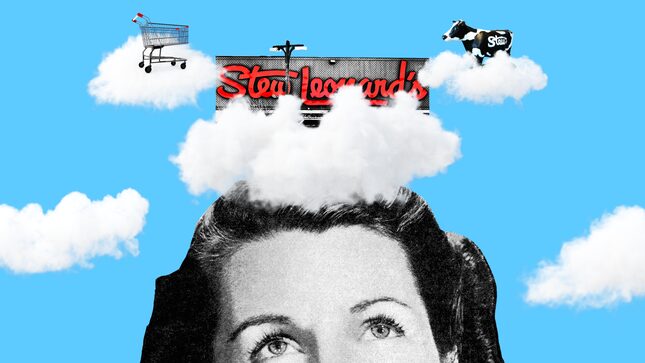
Graphic: Elena Scotti (Photos: Getty Images, Shutterstock)
High atop a hill in Yonkers, New York, across from a Costco and above a Home Depot rests the greatest grocery store that anyone has ever shopped at, Stew Leonard’s. Stew Leonard’s is more than a place to buy food; it is a top to bottom experience. Everything in the store is designed to elicit joy and encourage spending. The employees are friendly as if they’ve known you all their life and you’re visiting them at their farmers’ market stall. The food selection is vast, but not overwhelming. Even with so much to choose from, there is no wrong decision. Most of the groceries are Stew Leonard’s internal brand and are displayed to the buyer like museum artifacts, lit from above by lighting racks while the rest of the store is dim. The bread aisle smells like an artisanal bakery as Stew Leonard’s bakers roll out dough and dip apple cider doughnuts in hot oil to be sold the same day. The vegetables glisten from their hourly misting. It’s perfectly organized in such a fashion that customers can only travel in one direction, like IKEA but pleasant. No zigzagging through aisles to find what you’re looking for, instead, you calmly roll through the Stew Leonard’s maze, tasting samples, enjoying the tunes of a singing chicken in a store that looks like a farm, and allowing the groceries to find you. It is what all supermarkets should strive to be—if what supermarkets should be is out of reach to middle-class consumers.
Everything in the store is designed to elicit joy and encourage spending
For years I would see the market from the passenger seat of my mom’s car, as we turned into Costco. I’d wonder what it was like in that shining grocery store on a hill. We never went in. Stew Leonard’s and other upscale stores like it were in a special category of markets, the ones reserved for white people who purchased organic produce and farm-raised animals for their dinner table. We drove from the Bronx to buy bulk snacks from the closest Costco and didn’t have the time or the budget to peruse the aisles of a Stew Leonard’s. Even now, as a grocery-buying adult, the siren song of Stew Leonard’s still calls to me, but my budget muffles my ears.
Supermarkets have long been obvious signifiers of wealth in a neighborhood, a gap that has grown as the growth of the health and wellness industry has increasingly sorted the affluent by what they’re able to eat. As the middle class has been able to acquire more traditional signs of status—luxury cars, designer clothing, ranch-style homes—the truly wealthy turned to “inconspicuous consumption,” money spent on quiet luxuries that nonetheless signify status and prestige. As economic researcher Elizabeth Currid-Halkett explained to the BBC in 2017, this spending shift was caused by a number of things— “the mass-production economy of the 20th century, the outsourcing of production to China” and rising demands from the “middle-class consumer market” for affordable luxury—and happened slowly over a period of years.
To maintain their image of wealth, the rich began spending on expensive but immaterial things, like education and health, while still maintaining some focus on “less expensive but equally pronounced signaling – from reading The Economist to buying pasture-raised eggs,” Halkett wrote.
Stew Leonard’s and other upscale stores like it were in a special category of markets, reserved for white people who purchased organic produce and farm-raised animals for their dinner table
But to buy pasture-raised eggs, you must first venture to the “good” supermarkets found in most affluent neighborhoods across the country. Every area has its own Stew Leonard’s, a beloved local chain that has a curated, luxurious feel to it. Texas has HEB, the national chain beloved for its prepared queso and tamales; Arizona has Sprouts Famers Market, a supermarket that makes shoppers feel a connection to farmers by stocking a vast array of organic products; just about everywhere has a Whole Foods, which despite its high price tags, is the frugal watered-down version of Stew Leonard’s.
-

-

-

-

-

-

-

-

-

-

-

-

-

-

-

-

-

-

-

-

-

-

-

-

-

-

-

-

-

-

-

-

-

-

-

-

-

-

-

-








































